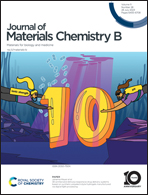Light-activated carbon dot nanozyme with scandium for a highly efficient and pH-universal bio-nanozyme cascade colorimetric assay†
Abstract
Nanozyme-based colorimetric assays have attracted much attention due to their cost-effectiveness, high stability, and sensitivity. In particular, the catalytic cascade imparted by the biological enzyme is highly selective. However, developing an efficient, one-pot, and pH-universal bio-nanozyme cascade remains challenging. Considering the tunable activity of the photo-activated nanozyme, we herein demonstrated a pH-universal colorimetric assay based on the Sc3+-boosted photocatalytic oxidation of carbon dots (C-dots). As a strong Lewis acid, Sc3+ shows ultra-fast complexation with OH− over a broad pH range and dramatically decreases the pH of the buffer solutions. In addition to regulating the pH, Sc3+ also binds to the C-dots to produce a persistent and strongly oxidizing intermediate based on photo-induced electron transfer. The proposed Sc3+-boosted photocatalytic system was successfully used in a cascade colorimetric assay with biological enzymes for assessing their activity as well as the detection of enzyme inhibitors at neutral and alkaline pH. Instead of designing new nanozymes for catalytic cascades, this work suggests that introducing promoters can be a convenient strategy in practical applications.

- This article is part of the themed collections: Nanozymes and #MyFirstJMCB


 Please wait while we load your content...
Please wait while we load your content...